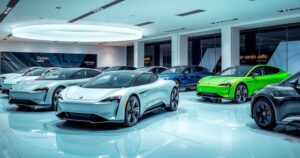Chevrolet vs China: The Battle for the Future of Uzbekistan’s Auto Industry

Uzbekistan’s auto industry, once dominated by Chevrolet, is witnessing a transformative shift as electric vehicles from Chinese manufacturers gain traction. The liberalization under President Mirziyoyev has introduced foreign competition, broadening consumer choices. Nevertheless, Chevrolet maintains stronghold in the market, facing challenges from rising EV popularity and changing consumer needs.
Uzbekistan’s automobile landscape has been dominated by Chevrolet for over two decades, with 90% of cars on the road sporting the Chevrolet brand and a significant majority being white. However, the increasing prevalence of electric vehicles (EVs) signifies a shift in this long-standing monopoly, as Chinese automakers target Uzbekistan’s market amidst a global shift toward electrification.
Under former President Islam Karimov, Uzbekistan modernized its auto industry by partnering with South Korea’s Daewoo in 1996 to establish a local manufacturing base. Following Daewoo’s acquisition by General Motors in 2002, the Chevrolet name grew synonymous with Uzbekistan’s transportation, significantly reducing the number of competing vehicles on the streets. This monopolized structure provided jobs and stability but limited consumer choice.
Since the election of President Shavkat Mirziyoyev in 2016, Uzbekistan has sought foreign investments and embraced free market principles, resulting in a diverse automotive market. Major players currently include South Korean brands Kia and Hyundai, alongside Chinese companies BYD and Changan. The government’s decision to eliminate tariffs on EVs in 2019 facilitated partnerships, notably with BYD, which established a production facility in Jizzakh expected to produce 50,000 vehicles annually.
Despite the influx of foreign brands, the Chevrolet stronghold remains robust, particularly in regions like Andijan, where only 4.5% of cars are not Chevrolet. Alisher, a local taxi driver, notes the high cost of electric cars compared to their well-supported Chevrolet counterparts in terms of necessary repairs and parts availability.
Experts like Sherzod Yuldashev acknowledge a growing adaptability among consumers toward EVs. As electric vehicle sales rise year by year, infrastructure and servicing capabilities are also improving. With prices for Chinese EVs already starting around $15,000, the market seems poised for significant change.
Chevrolet, however, faces challenges as its model offerings dwindle, unable to compete effectively with emerging brands. The introduction of non-tariff barriers by the government to protect local products further complicates the situation, although many consumers appreciate the increase in choices available to them.
In this evolving landscape, consumer precursors such as affordability and serviceability drive shifts, and even Chevrolet has had to adapt to pricing pressures from competing brands. The dynamics of Uzbekistan’s automotive industry are undoubtedly changing, reflecting broader global trends in vehicle electrification.
The battle for Uzbekistan’s automotive future is intensifying, marked by Chevrolet’s long-standing dominance and the imminent challenges posed by Chinese EV manufacturers. Recent market liberalizations and shifts in consumer preferences indicate a transition toward more diverse automotive choices. Despite Chevrolet’s entrenched position, the future may belong to innovative electric vehicles, compelling established brands to adapt to the realities of a competitive, evolving marketplace.
Original Source: timesca.com




